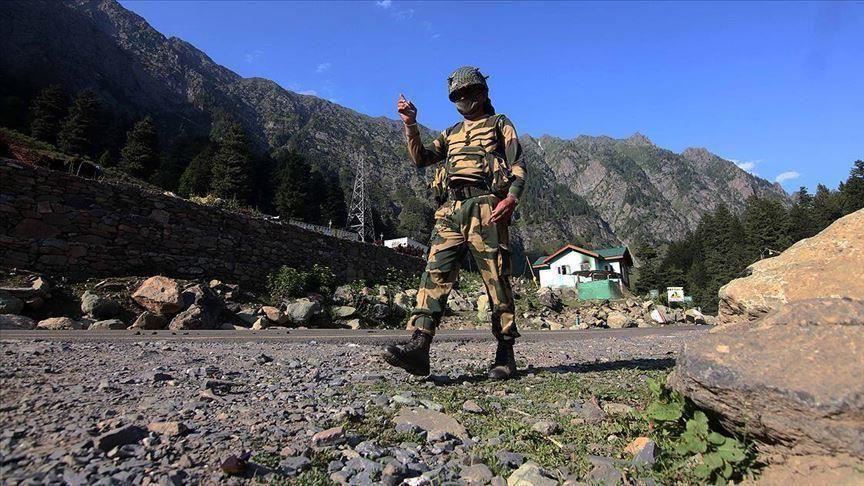India-China border tensions likely to escalate: Experts
New Delhi, Beijing witnessing heightened faceoff along de facto border between two heavyweights in Ladakh region

NEW DELHI
With tensions further escalating between India and China after both countries Monday accused each other of violating a “consensus” reached between the two sides after recent border clashes, political and military experts in India said the situation now is likely to get more complicated and tense.
“I think it [standoff] has become more complicated. There were already tensions on the LAC [the Line of Actual Control], and at least after the initial violence, things had sort of cooled down and talks were taking place at various levels,” Lt. Gen. Deependra Singh Hooda, a retired senior of the Indian Army, told Anadolu Agency. “Now suddenly, you have another fresh attempt, some kind of incursion (by China’s People’s Liberation Army) in a completely new area. So, things are going to get tense.”
New Delhi Monday said its troops thwarted “provocative military movements” in border areas of the Himalayan region where the two countries have witnessed a heightened faceoff since this May. Subsequently, China’s People’s Liberation Army also accused the Indian side of committing violations.
According to Hooda, with “escalation and enormous provocation” things will get further tense on the border. “If diplomatic talks and military-to-military engagement doesn’t work, and China continues to use its military forces as they have done now, I think everything is on the table now,” he said.
India and China confront each other along the LAC, a de facto border line between the two nations in the Ladakh region of the disputed Jammu and Kashmir region, where 20 Indian soldiers were killed this June. Since then a series of meetings has been conducted between the two countries, but without success.
Rajiv Ranjan, who teaches international relations at Shanghai University, told Anadolu Agency that the clashes in June in Ladakh have dented the India-China relationship. “With fresh tension reported, situation will remain tense and India might retaliate with limiting engagement,” he opined.
Ranjan said this year’s standoff is going to overhaul the whole relationship. “At least New Delhi is seriously pondering. But it’s going to be a long-term rather a short-term approach,” he said.
Is war imminent?
India’s Chief of Defence Staff Gen. Bipin Rawat last week stated the country has “military options” to deal with China if talks between the two countries fail.
“I don’t see a war happening but tensions will increase because when talks are taking place and suddenly you attempt to do something in a fresh area, it is an enormous provocation. I am saying both countries will not go to war. But, with all these things, who knows what will happen in coming time,” said ex-army commander Hooda.
Ranjan echoes the views of Hooda. “Leaders of both countries are mature enough to calculate the cost and benefit of the war. I believe that both sides will try to avoid a full-scale confrontation but as India and China are rising and are neighbors with long unsettled boundaries, more frictions are on the road ahead,” he said.
Political commentators in India believe the standoff may find a solution through diplomatic talks.
“I think that it will find a diplomatic settlement. Chinese have already pulled back in Galwan. Solution to the standoff is for both to work out a recognized Line of Actual Control,” Manoj Joshi, a distinguished fellow at New Delhi-based Observer Research Foundation and expert on India-China relations, told Anadolu Agency.
After the India-China clash in June, there were many calls in India to boycott the Chinese products. Indian daily The Hindu reported in June that Indian Railways also recently canceled a signaling project that was given to a Chinese firm.
Experts said clashes had led to an anti-China feeling among people in India.
“In the background of 20 Indian soldiers killed, there is a popular pent-up feeling in India against China. Public opinion polls have indicated it. Some organizations have called for a boycott of Chinese goods,” Srikanth Kondapalli, an expert on China affairs at Jawaharlal Nehru University in New Delhi, told Anadolu Agency. He said: “This movement is acquiring steam.”
Joshi, however, said a boycott is not a good idea. “In my view, it’s ... probably not sustainable. But it is an expression of anger among the people who support it,” he said.
China’s territorial sovereignty violated
Reacting to the fresh tensions, China Tuesday urged India to “immediately stop any actions leading to the escalation and complication of the situation” in the border region of Ladakh.
“India’s move has grossly violated China’s territorial sovereignty, seriously violated relevant agreements, protocols and important consensus reached between the two countries, and severely damaged peace and tranquility along the China-India border areas,” Ji Rong, a representative of Chinese Embassy in India, said in a statement. “What India has done runs counter to the efforts made by both sides for a period of time to ease and cool down the situation on the ground, and China is resolutely opposed to this.”
Ji Rong said Indian troops violated Monday the consensus reached in previous multi-level engagements and negotiations between China and India and “conducted flagrant provocations, which again stirred tension in the border areas.”
China’s People’s Liberation Army also accused the Indian side of committing violations. “Chinese troops are taking necessary measures in response to Indian troops’ provocations and will closely follow the situation and resolutely safeguard national sovereignty, peace and stability at the border area,” the army’s Western Theater Command said, according to China’s state-run tabloid Global Times.
Border tensions between the two countries span over seven decades. China claims territory in India’s northeast, while New Delhi accuses Beijing of occupying its territory in the Aksai Chin plateau in the Himalayas, including part of the Ladakh region.
Anadolu Agency website contains only a portion of the news stories offered to subscribers in the AA News Broadcasting System (HAS), and in summarized form. Please contact us for subscription options.







